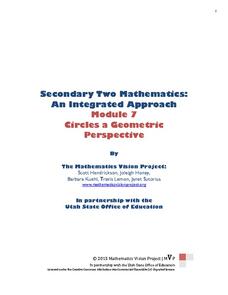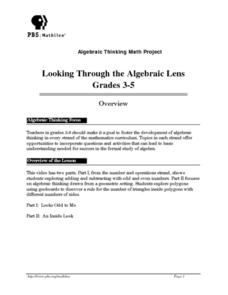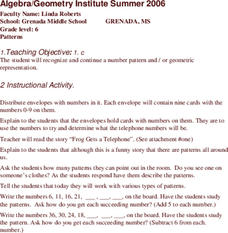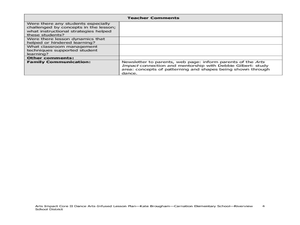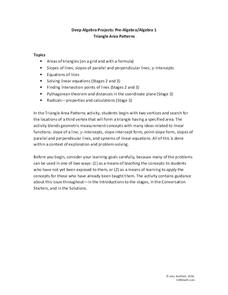Curated OER
Complete the Patterns
In this pattern completion worksheet, students observe groups of six patterns and add the final two patterns. Students complete five sets of patterns.
Mathematics Vision Project
Geometric Figures
Logical thinking is at the forefront of this jam-packed lesson, with young mathematicians not only investigating geometric concepts but also how they "know what they know". Through each activity and worksheet, learners wrestle with...
Mathematics Vision Project
Circles: A Geometric Perspective
Circles are the foundation of many geometric concepts and extensions - a point that is thoroughly driven home in this extensive unit. Fundamental properties of circles are investigated (including sector area, angle measure, and...
101 Questions
Domino Skyscraper
Can a domino knock over a skyscraper? An inquiry-based lesson asks learners to calculate the size of domino needed to topple the Empire State Building. Using specific criteria and a geometric model, they find a solution.
Alabama Learning Exchange
Unit Circle: Special Angles—Just Know One
It's all about the patterns! Young scholars learn that the unit circle repeats itself in all four quadrants. Using these patterns, they evaluate the sine, cosine, and tangent of special angles.
Willow Tree
Perimeter of Common Geometric Figures
Help learners understand that perimeter and circumference are one in the same. Learners apply their skills to determine the perimeter/circumference of triangles, rectangles, and circles. They then use the same strategy to find the...
Curated OER
Patterns Here, There, and Everywhere!
Upper graders access the Microsoft Word program and create patterns by utilizing certain keys on the keyboard. They create picket fences, smiley faces, and hearts. It seems that this lesson has as much to do with keyboarding skills as it...
Curated OER
Hop To It!
Students determine patterns. In this mathematics lesson, students act out a skit, play a sequence game, and complete patterns. Students use problems solving skills.
Curated OER
Symmetry of the Addition Table
Help your class discover the commutative property of addition with this exploration of the addition table. By folding and coloring the table, a symmetry is found that directs students to an understanding of this crucial mathematical...
Curated OER
Looking Through the Algebraic Lens
Students work with rectangles to find generalizations for adding and subtracting odd and even numbers in part one of the lesson. In part two, students use geoboards to construct polygons, look for patterns, and find a general rule.
Curated OER
Jumping Rules
First graders practice identifying number patterns. In this basic patterns lesson, 1st graders use a large number line and jump to certain numbers to create, identify or extend a pattern. This lesson includes a script to guide the teacher.
Curated OER
Patterns
Fifth graders recognize shape and number patterns. In groups, 5th graders use strategies to find patterns. They extend the patterns and give explanations as to how they found the pattern. Students use the computer and the hundreds...
Curated OER
Geometric & Arithmetic Patterns
Eighth graders explore sequences. They discuss the difference between an arithmetic sequence and a geometric pattern. Students participate in workstation activities where they determine arithmetic or geometric patterns and predict the...
Curated OER
Patterns
Sixth graders investigate the concept of patterns and how they can occur with numbers and the lesson focuses on the occurrance wiht shapes. They complete an activity investigating patterns using a story to set the tone of fun.
Curated OER
Geometric Shape Cakes
Students become problem solvers and communicate geometrical ideas. In this geometrical shapes activity, students make a cake template from geometrical shapes.
Curated OER
Shapes and Patterns in Art and Oceans
First graders draw, cut out, and design their own fish shapes by cutting out shapes and putting them together. In this shapes and patterns worksheet, 1st graders also construct a stamp and print patterns with stamps to repeat a...
Curated OER
Dancing Polygons and Non-Polygons with Patterns
Second graders study movements. In this dance lesson plan, 2nd graders draw patterns selecting one to represent through movement with their body.
5280 Math
Triangle Area Patterns
Combine algebraic and geometric strategies to find solutions. The task asks learners to find the coordinates of a third vertex of a triangle to create a triangle with a specific area. The project is a set of seven problems that helps...
Curated OER
Using Geometric Shapes To Make Patterns
Sixth graders explore the use of shapes to create geometric patterns. they start with a simple example of dividing shapes in half to create two new ones. This can be extended to creating intricate patterns.
Curated OER
Problem Solving Patterns
In this problem solving patterns worksheet, 6th graders solve and complete 2 various types of problems. First, they identify what the 4n represents in each block pattern illustrated. Then, students determine the number of arrows added to...
Curated OER
Patterns and Sequences
Sixth graders explore pattern recognition and sequencing. They create arithmetic and geometric sequences with colors, shapes, and numbers. Students write expressions of arithmetic sequences and geometric sequences to find the nth term.
Curated OER
Identifying Patterns
Students investigate the elements of a pattern. In this geometry instructional activity, students identify different shapes in a pattern and discover which shapes are missing in order to extend it. Students create their own patterns...
Curated OER
Investigation: Area of Geometric Shapes
Fourth graders explore geometry by utilizing pattern blocks. In this pattern lesson, 4th graders analyze two separate pattern block shapes and discuss which one is bigger and smaller. Students collaborate in small groups to create...
Curated OER
Sequences and Series: Geometric Sequence
For this geometric sequence worksheet, students find the next two terms of a geometric sequence. They identify the nth term and complete a sequence statement. Next, they find the geometric means of a given sequence. This one-page...




